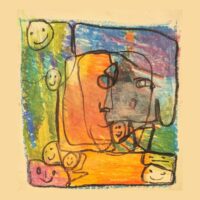Generational change seems to be accelerating, but the youth movements of the past need not feel so distant from today’s younger generations. Nathaniel Williams on the masks taken off in the 60s and put on by today’s youth.
In the 1950’s and 1960’s young people in the USA felt impelled to find a new spiritual orientation in life that could somehow accommodate who they felt themselves to be. They felt limited by the expectations of societal integration and participation of their parents’ and grandparents’ generations, which generally centered the church as a social and spiritual hub throughout all of life. Yet young people felt like this culture was inauthentic, something central was missing. It was somehow all empty. Looking for authentic encounter they were meeting masks. It was an experience like this among some young people in an earlier time that eventually led to the founding of the Youth Section at the Goetheanum.1
Many of the young people of the 60s went seeking for an imminent experience of spirituality that related to their experience of one another, and themselves. This is the time of the Rights Revolution,2 when the meaning of rights in the USA took on a whole new range of colors. The new language of rights demanded that the jurist’s craft be infused with a sense of awe. It was not only in legal discourse, but other areas of life this new coloring emerged. We can find it in the art of Helen Frankenthaler, Joan Mitchell, and Emily Mason and the poetry of Mary Oliver and Wendell Berry, or even in the music like Bob Dylan, Joan Baez, and Joni Mitchell. There is an explosion of interest in other cultures, places and also in other times. Native American spiritual traditions were of particular interest to many in the United States, but also spiritual culture from India, from Japan. It was felt that there was an immanence lacking in spiritual discourse in the USA and a desire to find it wherever one could.
Today we live in the midst of a world that takes great influence from these counter-cultural artistic, political, and spiritual movements of the 50’s, 60’s, and 70’s. We take it for granted. The rights revolution was so successful that in 2010 corporate lobby groups successfully argued at the Supreme Court for deregulation of federal political donations by framing it as curtailing the freedom of expression. We can also consider the popular echo of the interest in immanent spirituality in the recent blockbuster, Wakanda Forever.
Yet today, for young people who have grown up with the digital revolution, these movements from the middle of the last century feel both familiar and very far away at the same time. This is, in part, a kind of just trick mirror—this time and spirit is not so far away as it appears, and maybe not so foreign as we might think.
This is connected to the increasing maturation of the digital revolution. Young people, as a matter of course, are integrating these technologies into their lives. In these digital spaces, they have started to make avatars of themselves, whether it is a profile on Facebook or a character in a video game. We can see that now, from the future instead of the past, there’s another mask that appears. This mask is emerging as part of our new technology and it will certainly continue to grow and develop. These masks, if you will, are something that we put on, something we’re behind when we meet another person. And yet, these masks—the social media profiles, the characters, etc.—almost have an independent existence from the people who make them.
The “mask” that young folks were experiencing in the 60’s and 70’s was a kind of old mask, threatening to overtake their identity and their experience of authenticity. They were seeking their own truth and identity, so that the well-worn path that others had made for decades or centuries didn’t prevail in the world. Instead of following that path, they searched for ways to be true to their experience and their intrinsic faith in reformation and renewal of culture and society. The mask that today comes from the future has a kind of cold character, which diminished our ability to connect with the same immediacy and warmth that physical proximity and assemblies allow. It freezes us, in a way, and creates a pressure to present an avatar of ourselves that somehow is in line with cultural norms and expectations like hyper-consumerism, various political opinions and popular culture. Of course, this has always been a dynamic in human life, but because of the chasm between the avatar and the feeling for oneself, it is amplified today.
Many young people describe how despite the fact that social media, cell phones and the internet make connections possible, they actually feel like they’re more isolated. They spend more time alone and interact through digital technology and feel deeply separated from others. Young people are sharing that they feel less connected to real-time experiences and less able to just be present with one another. When they’re out, they might even find themselves communicating through their devices more than having conversations with those who they are with.3 Somehow our awareness of one is another becoming more difficult and less available. This has a paralyzing effect, almost like we’re being frozen, a subtle, soulful agility and nimbleness of our being is drained. This comes with a lot of fear and anxiety, and feelings of isolation and loneliness. These are common reports from young people who are struggling with this experience.4
One of the reasons that the new register of experience that emerged in the 1960s seems so far away is because of the influence of this second mask. The generation coming of age right now are the first human beings to come of age with these questions intertwined in their (your) development. It would be foolish to think technology will not continue to be integrated into outlives, and the experience of coming of age. Yet it will be increasingly important to develop complimentary forces and to develop and deeper understanding of this technology in relationship to the human constitution.
Photo Crowds during the 1963 March on Washington, in Washington. Photo taken by one of the staff photographers at U.S. News & World Report.
Footnotes
- Rudolf Steiner, The Younger Generation. GA 217.
- Charles Epp, The Rights Revolution: Lawyers, Activists, and Supreme Courts in Comparative Perspective (University of Chicago Press, 1998).
- Sherry Turkle, Alone Together: Why We Expect More from Technology and Less from Each Other (Basic Books, 2012).
- Matt Richtel’s series in the New York Times.













